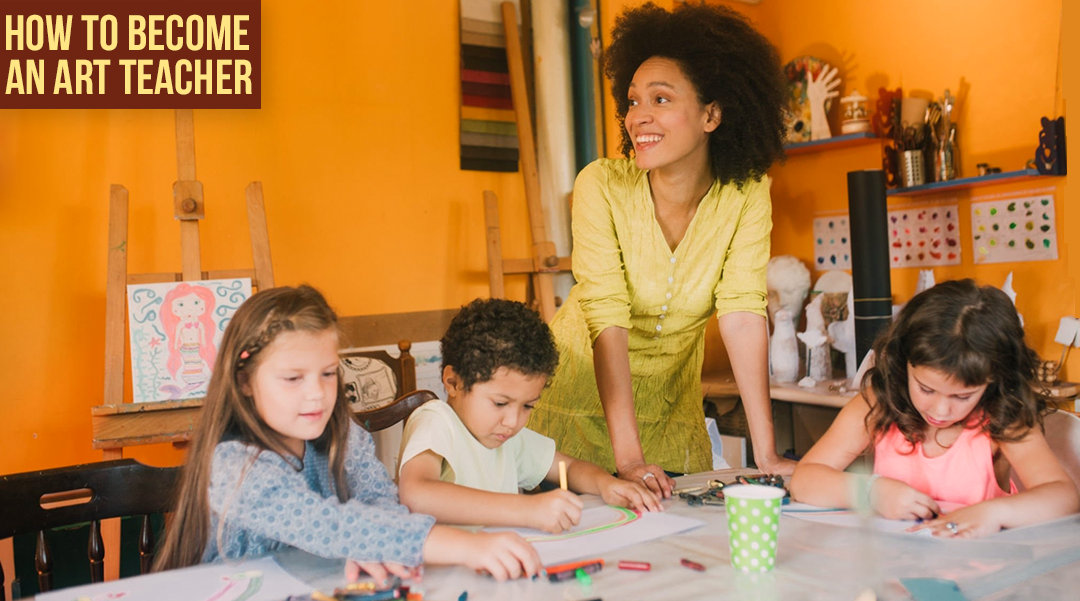Your Cart is Empty
- Ornament 🔥
- Gift for Family 🏠❤️
-
Pet
-
Memorial
-
Products
-
Home & Garden
-
Accessories
- Happy Customers ❤️
Unleash Your Palette: How to Become an Art Teacher and Inspire the Next Generation
August 29, 2023 7 min read

Are you the type who doodles in the margins of notebooks, finds solace in swirling colors on a canvas, or marvels at the play of light and shadow? If so, have you ever considered sharing your passion for art with eager minds? Welcome to the realm of art teaching, where the canvas isn't just a piece of paper, but a fertile ground for cultivating creativity in others. The journey of how to become an art teacher is like mixing the perfect hues - it requires a blend of education, dedication, and a splash of charisma.
Contents
1. Nurturing the Seedling - Requirements and Education 2. Crafting the Lesson - Developing Your Teaching Style 3. Setting the Canvas - Creating an Inspiring Environment 4. Strokes of Impact - Making a Lasting Mark as an Art Teacher 5. Conclusion: Embrace Your Artistic Journey as an Inspiring Art Teacher

1. Nurturing the Seedling - Requirements and Education

Embarking on the path to becoming an art teacher requires more than just a passion for creativity; it demands a palette of qualifications, knowledge, and a genuine desire to shape budding artists. Here are the steps to set you on the right course, helping you bloom into a nurturing and impactful art educator:
A. Educational Foundation:
- Begin by pursuing a Bachelor's degree in Fine Arts, Art Education, or a related field. This educational foundation equips you with the necessary skills and insights to traverse the world of art instruction.
- Immerse yourself in courses that encompass various art forms, art history, pedagogical methods, and child psychology. This comprehensive approach ensures you're well-prepared to cater to diverse student needs.
B. Certification:
- Depending on your location, acquiring teaching certification or licensure is often a mandatory step. This formal recognition validates your commitment to shaping young minds through the captivating world of art.
- This process usually involves passing exams and meeting specific educational criteria. It's akin to a brushstroke of approval on your journey to becoming an art teacher.
C. Master's Touch (Optional):
- For those seeking to refine their skills and knowledge even further, pursuing a Master's degree in Art Education is a valuable option. This optional step adds layers of depth to your expertise, encompassing curriculum design, educational theory, and advanced teaching techniques.
- While not a prerequisite, a Master's degree can set you apart in a competitive landscape, akin to adding intricate details to a masterpiece.
D. Brushing Up on Skills:
- Just as artists continually refine their craft, aspiring art teachers should elevate their artistic skills to an impressive level. This isn't limited to a single medium; an art teacher should be adept at multiple techniques to inspire and guide students effectively.
- Your ability to wield a palette knife, manipulate digital tools, or mold clay mirrors your commitment to being a versatile and adept mentor.
E. Gaining Experience:
- Theory without practice is like a canvas without color; it lacks vibrancy. Interning or volunteering at schools, community centers, or art studios provides invaluable hands-on teaching experience.
- This immersive engagement helps you develop a unique teaching style, understand student dynamics, and refine your classroom management skills.
Each step on this journey is a brushstroke on the canvas of your transformation into an art teacher. The blend of educational qualifications, hands-on experience, and an unwavering commitment to fostering creativity creates a vibrant self-portrait of an aspiring art educator.
2. Crafting the Lesson - Developing Your Teaching Style

Just as each artist has a unique style that defines their work, every art teacher brings their own flair to the classroom. As you delve into the intricacies of how to become an art teacher, consider the following steps to mold your teaching approach and create a classroom that resonates with creativity:
A. Blend Theory and Practice:
- Art education isn't just about techniques; it's the marriage of theory and practice. Craft lessons that seamlessly intertwine art theory with hands-on practice, encouraging students to understand the "why" behind their brushstrokes.
- By fostering this understanding, you create a strong foundation upon which your students can build their artistic prowess.
B. Captivating Curriculum:
- Your lesson plans are the brushstrokes that compose the larger masterpiece of your teaching journey. Designing engaging and diverse lesson plans is crucial to catering to various learning styles within your classroom.
- Introduce students to an array of art forms, from traditional painting and sculpture to contemporary digital art and experimental mixed media. This ensures that every student finds their own creative niche.
C. Interactive Demonstrations:
- "Show, don't tell" takes on a new dimension in an art classroom. Interactive demonstrations allow you to guide students through various artistic techniques, from the delicate strokes of watercolors to the bold textures of impasto.
- This approach keeps students engaged and provides a clear visual reference for their artistic endeavors.
D. Critique and Feedback:
- Just as artists rely on feedback to refine their work, students benefit from constructive criticism. Teach them the art of giving and receiving feedback, creating an environment where growth is celebrated.
- By nurturing this skill, you empower your students to view criticism not as a setback, but as a stepping stone toward improvement.
E. Artistic Show and Tell:
- "Show and tell" isn't just for kindergarteners; it has a place in an art classroom too. Organize exhibitions or showcases to display your students' work, giving them a sense of accomplishment and boosting their artistic confidence.
- These events celebrate the journey of each student, turning your classroom into a gallery of creativity.
As you paint the canvas of your teaching career, remember that your style is a blend of your artistic essence and your passion for nurturing the next generation of artists. Each stroke of your teaching approach contributes to the masterpiece that is your classroom.
3. Setting the Canvas - Creating an Inspiring Environment

An art classroom isn't merely a room with desks and easels; it's a realm of inspiration and expression where creativity takes center stage. When exploring the multifaceted journey of how to become an art teacher, consider these essential elements to craft an environment that ignites artistic passion:
A. Colorful Ambiance:
- The walls of your classroom aren't limited to white. Infuse them with vibrant artwork, posters of renowned artists, and captivating visuals that celebrate the world of art.
- This colorful ambiance sets the tone for creativity and serves as a constant source of inspiration for both you and your students.
B. Resource Treasure Trove:
- An artist is only as powerful as their tools. Provide your students with access to a treasure trove of art supplies, ranging from classic watercolors and sketchpads to cutting-edge digital tools.
- By ensuring that every student has the resources they need, you empower them to explore various mediums and techniques.
C. Personal Connections:
- Art is deeply personal, and so is the connection between an art teacher and their students. Take the time to know each student's aspirations, strengths, and challenges.
- This personalized approach not only helps you tailor your teaching to individual needs but also fosters trust and a sense of belonging within the classroom.
D. Artistic Excursions:
- Sometimes, inspiration isn't confined within the four walls of a classroom. Organize excursions to museums, galleries, art installations, and workshops that expose students to the broader world of art.
- These artistic journeys expand their horizons and encourage them to view art as an integral part of life, beyond the classroom setting.
F. Spontaneity Rules:
- The magic of art often lies in the unexpected. Embrace spontaneity and flexibility in your lessons, allowing students to explore tangents and unplanned artistic avenues.
- These detours can lead to breakthroughs, innovation, and a deeper appreciation for the unpredictable nature of the creative process.
Remember, you're not just creating a physical space; you're cultivating an atmosphere that nurtures artistic growth, encourages exploration, and celebrates the unique creative journeys of your students. Your classroom becomes a canvas itself, waiting to be adorned with the strokes of creativity.
4. Strokes of Impact - Making a Lasting Mark as an Art Teacher

As an art teacher, your impact can ripple through generations. Here's how to leave an indelible mark:
A. Encourage Fearlessness: Teach students that art has no boundaries. Encourage them to step out of their comfort zones.
B. Foster Critical Thinking: Use art as a platform for discussions on cultural, societal, and personal issues.
C. Celebrate Diversity: Showcase artists from different backgrounds and cultures. Highlight the beauty of artistic pluralism.
D. Empower Through Expression: Help students channel emotions and thoughts into their artwork. Art can be a powerful form of self-expression.
E. Legacy of Creativity: Inspire students to become lifelong learners and lovers of art, nurturing the creative flame in their hearts.
So, whether you're already dabbling in the world of art or considering a career switch, the path of how to become an art teacher offers a canvas of endless possibilities. With the right mix of education, passion, and dedication, you can become a guiding light, shaping young artists and leaving your vibrant mark on the world.
5. Conclusion: Embrace Your Artistic Journey as an Inspiring Art Teacher

Congratulations! You've journeyed through the vibrant landscape of how to become an art teacher, and now you're standing at the threshold of an exciting and meaningful path. As you step into this role, you're not just imparting artistic skills; you're nurturing young minds, igniting creativity, and fostering a lifelong love for art.
Armed with a solid foundation, your unique teaching style, and a vibrant classroom environment, you're ready to make a lasting impact. Remember, your influence extends beyond the classroom, empowering students to fearlessly express, think critically, and celebrate diversity through art.
Embrace this journey with open arms, and watch as you leave colorful strokes on the canvas of countless artistic futures. Becoming an art teacher isn't just about a career choice—it's about becoming a source of inspiration, a guide to exploration, and a mentor who shapes the artists of tomorrow.
Related articles in Teacher

Unlocking Success: How to Ask a Teacher for a Letter of Recommendation
September 08, 2023 7 min read
Explore the ultimate guide to becoming an elementary school teacher, from qualifications to practical tips, and embark on a journey to shape young minds.
Read More
Mastering the Path: How to Become an Elementary School Teacher
September 08, 2023 6 min read
Explore the ultimate guide to becoming an elementary school teacher, from qualifications to practical tips, and embark on a journey to shape young minds.
Read More
 Track Order
Track Order